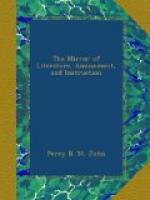* * * * *
THE NATURALIST.
* * * * *
NOTES
Abridged from the Magazine of Natural History.
[Illustration: (The Fern Owl, showing the greater length of the middle claw, and its provision for the peculiar posture of the bird.)]
Habits of the Fern Owl, by Rusticus.—Beyond Godalming, on the Liphook road, is a great tract of barren heathy land: it stretches wide in every direction, and includes immense peat-bogs, and several large ponds. One particular district, called the Pudmores, is the favourite resort of the fern owl. In the daytime, while walking across the moor, you will every now and then put up one of these singular birds; their flight is perfectly without noise, and seldom far at a time: but of an evening it is far different; about twenty minutes after sunset, the whole moor is ringing with their cry, and you see them wheeling round you in all directions. They look like spectres; and, often coming close over you, assume an unnatural appearance of size against a clear evening sky. I believe its very peculiar note is uttered sitting, and never on the wing. I have seen it on a stack of turf with its throat nearly touching the turf, and its tail elevated, and have heard it in this situation utter its call, which resembles the birr of the mole-cricket, an insect very abundant in this neighbourhood. I have almost been induced to think this noise serves as a decoy to the male mole-cricket, this being occasionally found in the craw of these birds when shot. Those who may not be acquainted with the cry of the bird or the insect, may imagine the noise of an auger boring oak, or any hard wood, continued, and not broken off, as is the noise of the auger, from the constant changing of the hands. The eggs of the fern owl have frequently been brought me by boys: they are only two in number, greyish white, clouded and blotched with deeper shades of the same colour; the hen lays them on the soil, which is either peat, or a fine soft blue sand, in which she merely makes a slight concavity, but no nest whatever. The first cry of the fern owl is the signal for the night-flying moths to appear on the wing, or rather the signal for the entomologist expecting them.
The migratory periods of this bird are not well ascertained; but I have known one shot Nov. 27th, 1821, and they had arrived April 28th, 1830. As there is scarcely a British bird of which so little is known, the following notes may be interesting:—It has been seen perched on the bar of a gate, not across, but according to its length, with the tail elevated; uttering its peculiar sounds; but when perching, as it often does, on the summit of a twig of oaken copse, it fixes upright, with the feet grasping the twig, and not sitting; just as the swift perches against a wall. One was killed in broad daylight, perched on the upper




